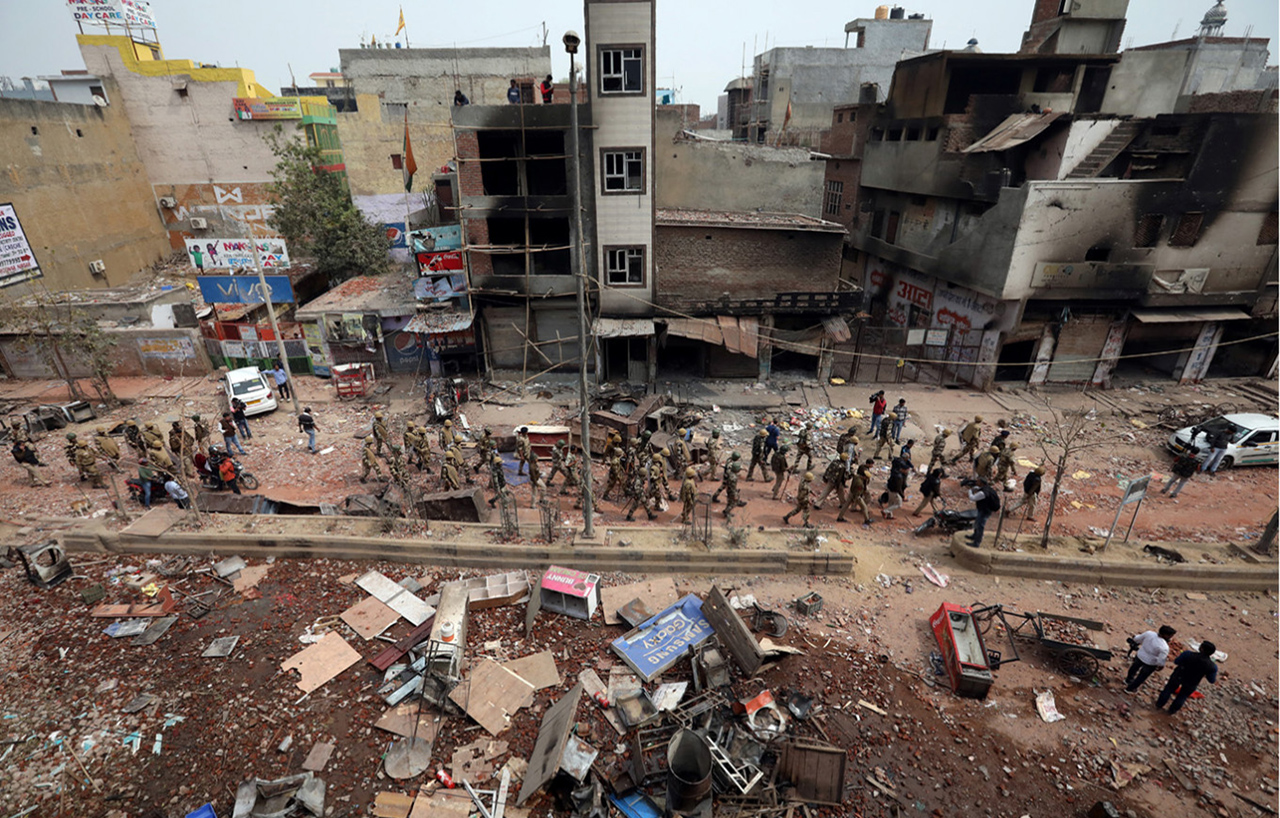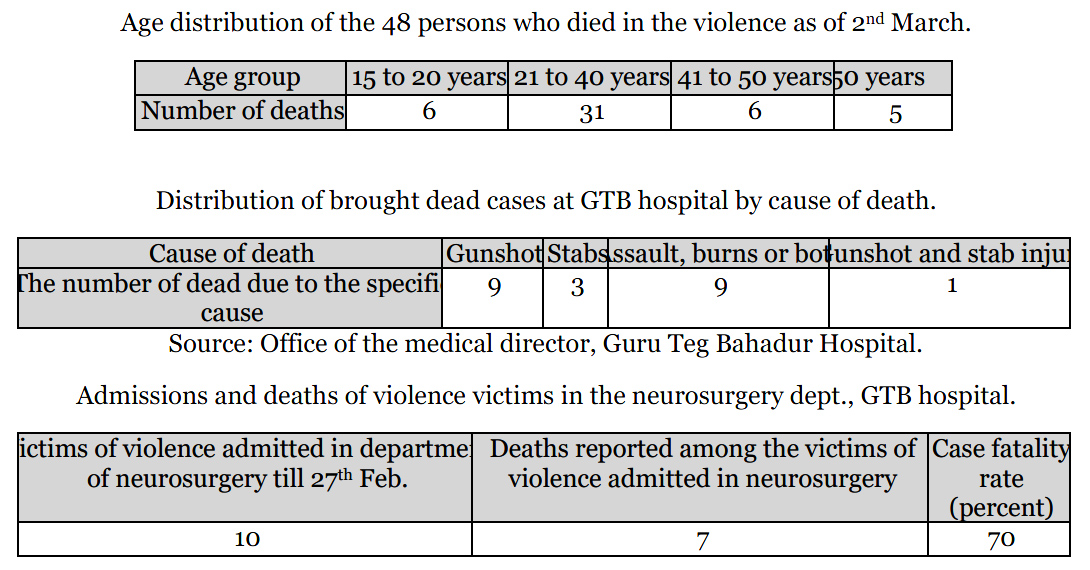We bring to our readers a brief summary of the inquiry report into the anti-Muslim violence in northeast Delhi by a team of PMSF (Progressive Medicos and Scientists Forum) doctors, who visited the riot affected areas to provide urgent medical help to the victims. The inquiry report was released in the form of a Press Release by PMSF.
Members of the medical team:
1. Dr Vikas Bajpai – Assistant Professor, Centre for Social Medicine and Community Health, Jawaharlal Nehru University, New Delhi (Ph: 9717820427).
2. Dr Harjit Bhatti – Former President, Resident Doctors Association, All India Institute of Medical Scientists (AIIMS) (Ph: 8586848479).
3. Dr Sumitran – A consultant radiologist with a government hospital in Delhi.
4. Five doctors from the All India Institute of Medical Sciences
Violence had broken out in the area on 23rd evening itself. From the evening of Sunday the 23rd of February, 2020 itself, there were several calls and appeals for urgent medical aid to be reached to the affected area. We made repeated attempts to reach the violence hit area on the 24th and the 25th, but these were foiled by the police and the rioting mobs. We finally managed to reach the Al Hind hospital in Old Mustafabad area of Northeast Delhi, on Wednesday, the 26th of February. The Al Hind hospital was one medical facility that had been totally overwhelmed by this tragedy. Apart from 26 February, PMSF doctors also visited the violence affected areas on 28th February as well.
Main findings of the study
- Describing the situation in the Al Hind hospital on the evening of 23rd, 24th and 25th, one of the doctors at Al Hind hospital told:
“……….. people who were still alive, writhing with agony had come to the Al Hind hospital. We did not even have the courage to look at them; we were becoming dispirited. But it is the local people of this area who gave us courage. They said – ‘Doctor sahib if you lose heart like this then we will die; We shall lose all hope.’ It is the people of this area who have assured us. ……… We do not even know that those who died were Hindus or Muslims. We were weeping because we were seeing people die of their agony and that we were feeling helpless.”
- A hospital that catered to 30 to 40 patients daily, and that too suffering from common ailments, was simply overwhelmed with more than 200 patients who came on the 24th February itself. By 25th February, this figure reached 350 to 400.
- Nearly seventy-five percent of the cases were those who had sustained piercing injuries either from charras (pellets), or bullets. Of the rest, majority had fractured limbs or skull etc.; asmall proportion was simple blunt injuries or grievous injuries, for example burn injuries. There was a rampant use of firearms in this violence.
Age distribution of the 48 persons who died in the violence as of 2nd March.
- Even though government ambulances were stationed on the main highway, they were not allowed inside the localities resulting in unnecessary loss of lives and enhanced suffering for those injured.
- A young man with fractured skull and part of his brain popping out had to be taken on trolley to the ambulance stationed near the police barricade on the main road. But when the patient reached the barricade, the injured men accompanying the patient were severely beaten up by the Delhi police men stationed there whose constant refrain was – ‘inhone hamaare do-teen log mare hain; das-pandrah inke bhi marne do.’ It was only upon persistent pleading and intervention by the CRPF personnel that the police ultimately allowed the patient to be taken to GTB hospital.
- Another young man’s testicles were chopped off by men reportedly shouting ‘Jai Shri Ram’, and the attendants accompanying the man had told the doctors that the attackers first pulled his legs apart stretching the area where the lower limbs converge (the perineum), causing a massive tear and then deepened it with a sharp edged weapon.
- Two young males presented with bullets lodged in their bodies, a good two days after sustaining the injury. One of them had a bullet in the left axilla, while the other had a bullet in the abdomen.They had been hiding for more than forty-eight hours out of fear of the police, which they said would more likely treat them as rioters rather than as victims. When suggested to go to the GTB hospital immediately, they refused saying that they would rather die a respectable death at home than die due to neglect in the hospital. Finally, both of them agreed to go to GTB hospital with Dr Bhatti accompanying them. Within a distance of a kilometre to the highway, the policemen stopped the ambulance four times, and each time they removed the dressing over the bullet wound to check it for themselve, despite Dr Bhatti assuring them that he is a former specialist doctor of AIIMS. Most shockingly, the policemen insisted that ‘you can only transfer the patient’ and made the victim’s relative disembark from the ambulance.
The sincerity and quality of medical response of the government
- Even as the dead bodies in the GTB hospital mortuary were mounting, the hospital authorities failed to perform the post-mortems of these bodies within time, as they were waiting for “instructions” from the government, indicating the possibly of attempting to tamper with the cause of death. Finally, the post-mortems were carried out after the order dated 26 February, 2020, issued by the Delhi Minorities Commission instructing the Superintendent of GTB hospital– “….. to conduct post-mortem procedure on all these bodies and on any fresh cases within 24 hours of arrival of each dead body.”
- Numerous cases of inappropriately treated fractures and bullet injuries were encountered.
- There was not even one ‘Mohalla Clinic’ in the entire Mustafabad area and as regards coverage under publicly funded health insurance schemes, it was said: “Many of the poor people in the area are migrant labourers who have come from other states; they neither have the documents required for coverage under such schemes, nor are they actually covered. Anyways, which private hospital will be willing to provide ‘world class treatment’ to these victims of violence who have been pouring in to Al Hind hospital over last three days.”
- Even as government agencies were completely absent from relief work, a large relief camp had been set up by the Delhi Waqf Board by pitching in tents within the Idgah premises in Shiv Vihar. We set-up our medical camp within this compound, as indeed were other medical relief camps by the St. Stephens Hospital, Holy Family Hospital and some other NGOs. In any society that claims itself to be secular and non-discriminatory towards any section of its people, it is the government that is looked upon as the principal guarantor of these values. Provisioning of relief either by or through religious organizations primarily reinforces the belief that people can ultimately depend only on their religious organizations in times of crisis. This cannot but undermine the secular credentials of the state.
Despite being the National Capital Territory of India; despite the fact that some of the best medical institutions of the country of national and international repute, as also the fact that Delhi has hospitals which attract a large number of international patients by way of medical tourism, none of this stands any guarantee of easily accessible, effective medical care for the people in the times when medical catastrophe strikes, given the fact that the victims of such catastrophe are invariably the poorest segments of the society.
Just as there is behaviour of the people with respect to seeking health care, there is also the behaviour of health institutions. The experience of this violence directed primarily against the Muslim minority, actually shows that dominant social and political attitudes can make health institutions inaccessible to the suffering masses even though these may be physically located right in the midst of the people. Instead of reaching out to the people in the most testing of the times, the public health institutions, let alone the private ones, clearly fell much short of what was expected of them.
Some recommendations for alleviating the immediate suffering
Winning back peoples’ confidence by providing them effective relief and assuring them that the society at large does not share the world view of those who attacked them and that of their political sponsors, remains a big challenge for all of us. The tragedy is too huge to be mended by the efforts of civil society alone. There has to be a large-scale organized effort on part of the government to heal the physical, mental, psychological, social and financial wounds which have disfigured the lives of people in the violence affected areas of Northeast Delhi. Towards this end we feel the following measures can be of immense help in providing medical and other relief to the affected people.
- There clearly is a need for medical services to proactively reach out to the community in the violence affected areas, seek out the patients and provide them effective treatment for physical injuries, mental and psychological trauma in facilities existing or created closest to their homes. Only those cases requiring specialized care in hospital settings need be shifted to hospitals.
➢ Outreach teams constituted of doctors, and other paramedical staff, equipped with necessary equipment, medicines and other consumables be constituted forthwith.
➢ Existing public infrastructure in different localities be used to create field hospitals, may these be government dispensaries, urban Primary Health Centres or the schools and other such places.
➢ Social workers and civil society volunteers need to be deployed in large numbers to reach out to the people house to house and inquire about the injured or those sick and requiring help. Help need be taken in this regard from departments of Social Work in universities in Delhi.
- In the hospitals nearest to the affected areas, a ward need be separately designated for some time to expeditiously deal with cases of serious injuries due to communal violence. If separate facilities can be established in the hospitals to deal with cases of such infectious diseases, the same needs to be done with respect to treating the victims of such communal violence as well. In the outbreak of violence of the kind Northeast Delhi has been a witness to, death could sometimes be far more imminent than in case of an outbreak of a dreaded infectious disease. The high case fatality among victims of violence pointed to above clearly establishes this.
- Mental and psychological health care is a pressing need when it comes to dealing with the victims of such violence. Teams of psychologists and mental health experts shall have to be created to provide the necessary counselling and medical relief in this regard on a more long-term basis. This constitutes a necessary measure to fortify the healing touch.
(We have deliberately concealed the identity of five doctors from All India Institute of Medical Sciences on a precautionary note to avoid trouble from the administration. However, we wish to acknowledge that this effort could never have succeeded without their yeoman service and support. Dr Harjit Bhatti (National Convener) and Dr Vikas Bajpai are members of PMSF. Dr. Sumitran and others went with the team though they are not members of PMSF.)
For further details contact-
Progressive Medicos and Scientists Forum
Dr Harjit Bhatti (Convener): 8586848479;
Dr Vikas Bajpai: 9717820427


